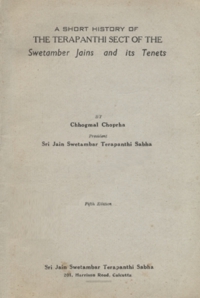The Founder of the sect Sree Sree 1008 Sree Sree BHIKHANJI MAHARAJ laid down that all Sadhus and Sadhwis must always be under the guidance and control of one Acharyya and this rule has all along been followed by this sect.
In Terapanthi Sect all the Sadhus Sadhwis are under the guidance and control of one Acharyya who is called Sree Pujyaji Maharaj. He is the Supreme Head of the Order and all Sadhus and Sadhwis owe allegiance to Him and obey His command and follow His instructions. He is the highest spiritual authority and all Sadhus, Sadhwis, Sravaks and Sravikas pay their unstinted homage to Him. He is the highest living deity - the object of the greatest reverence of all followers, laymen or Sadhus. He is the brightest Moon round whom the entire system of stars move. He is the Heart and soul of the entire organisation of the Chaturvid Sangha of the Jain Swetambar Terapanthi Sect. He is the greatest Administrator of law and discipline, the commander-in-chief under whom moves the whole noble band of warriors for the emancipation of soul.
Dr. Hermann Jacobi. The reputed Jain Scholar of Bonn University, Germany, when he came in India in 1913, visited the eighth Acharyya Maharaj of the Terapanthi Sect, saw the Hajri or public examination of Sadhus & Sadhwis and initiation of the Saduhs and studied their mode of life and was much impressed with what he saw. In the book "DER JAINISMUS" published by Dr. Glasenapp, a pupil of Dr. Jacobi at page 354 is quoted the opinion of Dr. Jacobi about the Terapanthi Sect, and it runs thus: -
"Das jeweilige Oberhaupt, der Pujyaji Maharaj hat eine dem Jesuitengeneral vergleichbare Stellung; alle Mönche schulden ihm unbedingten Gehorsam und müssen sich täglich durch einen unterschriebenen Revers dazu yerpflichten."
Translated in English it says:
"The strange thing in this, with us still almost unknown Sect, is that a very strict holy custom, rules with them. The constant Head, the Pujyaji Maharaj, has a position, which equals that of the General of the Jesuits. All monks owe him strict obedience and have to bind themselves to the same daily, by the signing of a document".
The Acharyya is the supreme head, whom all the Sadhus and Sadhwis obey at all times and at all places but in places where the Acharyya Maharaj is absent, a Sadhu is strictly enjoined to obey and respect the orders of his superior as appointed by the Acharyya. Whenever and wherever several Sadhus meet, they would place the superior leader appointed by the Acharyya as their head and do all work under his direction and order. A capable but junior Sadhu may be appointed leader of a batch by the Acharyya and though he shall have to pay his daily respects to his senior in initiation, the senior would have to follow the orders of the junior leader. No one of the Sadhus of this sect is to live a free life, where he has to pay allegiance to none arid obey none. That is the reason why there is such discipline and order among the 636 or so of Sadhus and Sadhwis of this sect who have to frequent and travel in far and away places in different towns and provinces. Their sole and whole object is to lead a life dedicated to the betterment of soul and uplift of humanity. They do not become Sadhus for name and fame. To illustrate this strict rule of discipline, the following incident from the history of the Terapanthi Sadhus may be cited.
Usually the Acharyya nominates his successor or next Acharyya but the sixth Acharyya Swami Maniklalji suddenly passed away without having nominated any successor, on Kartik Badi 3rd, Samvat 1954. It was during the rainy season that he breathed his last. After his death the Sadhus of the sect remained, where they were till the end of Chaturmasa and then with the sole object of choosing a leader they moved towards a central place and met at Ladnun and there nominated on Pous Bodi 5, 1954 Swami Dalchandji, as the seventh Acharyya, For nearly two and a half months, there was no Acharyya but such was their discipline that each one of them obeyed the superior Sadhu among them and when all met after Chaturmasa, by common consent Swami Dalchandji was selected as the fittest person to lead them, although he was not present there. He was installed on the Gaddi of the Acharyya after he reached Ladnun, on Magh Badi 2, 1954. This shows at once that by their training and discipline the Terapanthi Sadhus and Sadhwis are precluded from adopting any course which is against the Sastric injunctions or in any way improper.
 Chhogmal Choprha
Chhogmal Choprha
